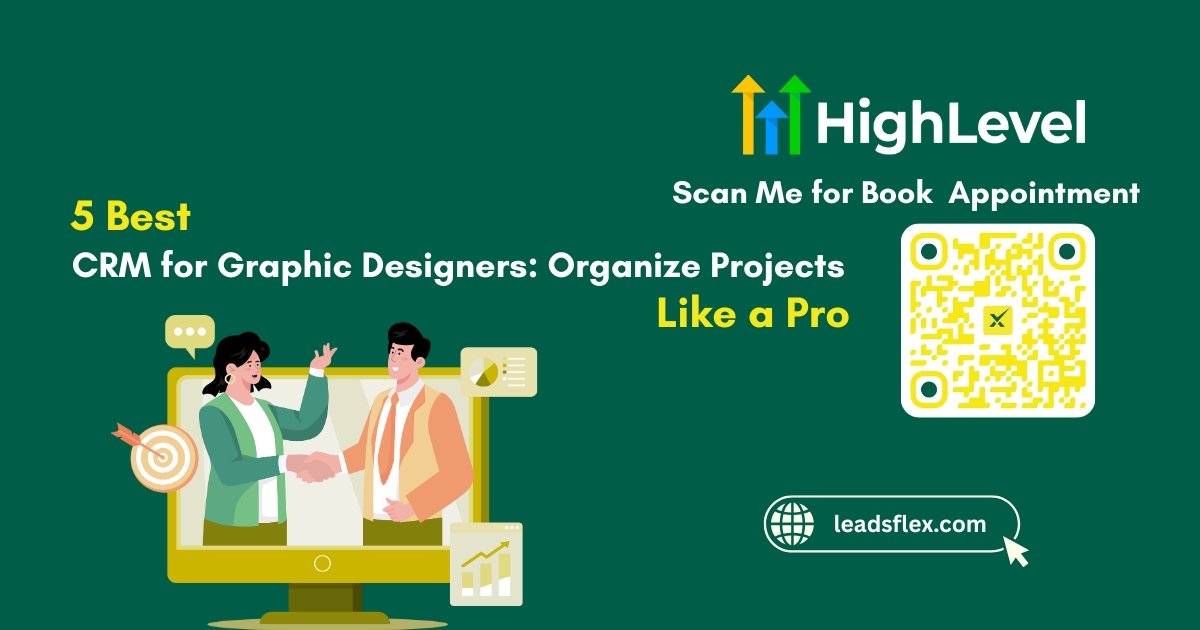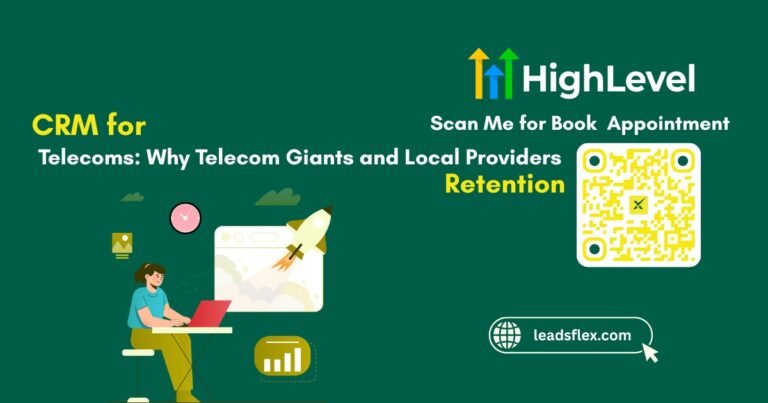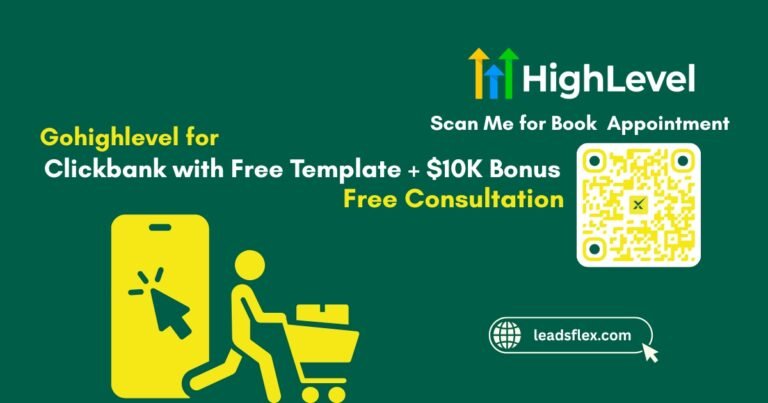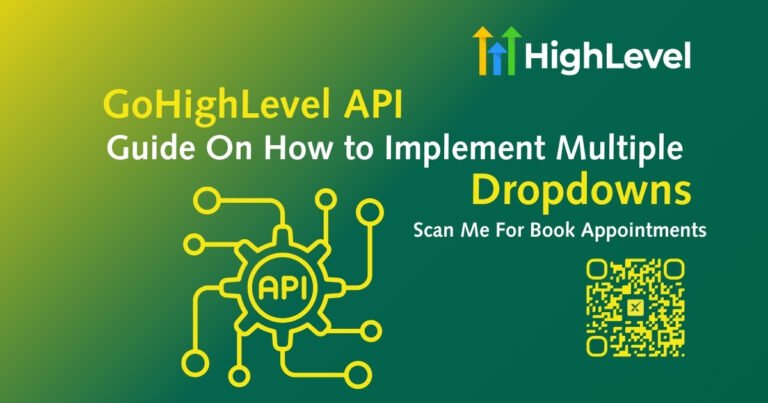5 Best CRM for Graphic Designers: Organize Projects Like a Pro
Graphic design is more than making things look good. It is also about keeping track of clients, projects, and deadlines. Without a clear system, things can get messy fast.
A CRM helps keep everything in order. It stores client details, tracks progress, and organizes conversations in one place.
For designers, this means less time spent on admin work and more time for creativity. No more hunting through old emails.
In this guide, we will look at the five best CRM tools for graphic designers. The right choice can make your work smoother and your clients happier.
Key Takeaways
Top 5 Best CRM for Graphic Designers: Comparison Overview
| CRM Name | Best User | Key Strengths |
| GoHighLevel | Agencies, freelancers, growing design studios | All-in-one client management, funnels, automation, SMS/email campaigns, subaccounts |
| Dubsado | Freelance designers, small studios | Workflow automation, contracts/proposals, invoices, client portal |
| Zoho CRM | Small to mid-sized creative teams | Lead/contact management, workflow automation, reporting, integrations |
| Trello | Freelancers, collaborative teams | Visual boards, task tracking, checklists, integrations, customizable workflow |
| Monday.com | Teams and studios with multiple clients | Custom workflows, timeline/calendar views, automation, file management, collaboration |
GoHighLevel
GoHighLevel is a smart CRM for graphic designers who need to organize clients, projects, and marketing in one place. It simplifies work and keeps everything accessible.
From scheduling to follow-ups, GoHighLevel streamlines tasks. You can track projects, deadlines, and client feedback without juggling multiple apps or spreadsheets.
Automation handles repetitive tasks. Emails, texts, and reminders are sent automatically. Your clients stay informed, and you stay focused on creating designs.
It adapts as your business grows. Multiple clients, campaigns, and projects can be managed simultaneously while maintaining smooth workflows and clear communication.
Key Features
Limitations
If you want a CRM that organizes clients, projects, and marketing all in one place, GoHighLevel is the best CRM for designers looking to scale. Try it free for 30 days!
Pro Tip
Create custom tags for colors, design styles, or branding moods. This allows you to quickly pull past work that matches a client’s aesthetic or inspiration request.
Dubsado
Dubsado is a client management platform built for creative professionals and small businesses.
It helps graphic designers organize projects, manage leads, and streamline client communication all in one place.
With Dubsado, you can automate workflows, send contracts, and track invoices without using multiple tools. Project details, deadlines, and client files stay in one centralized dashboard. This ensures you spend less time on admin and more time designing.
The platform also simplifies client onboarding. Customizable forms, questionnaires, and proposals allow you to gather project requirements, set expectations, and start work faster.
Key Features
Limitations
Read this: Top 5 Best CRM for Food Industry: Stop Wasting Time and Money
Zoho CRM
Zoho CRM is a versatile platform that helps creative professionals manage clients, leads, and sales efficiently. For graphic designers, it centralizes communication and project data in a single, easy-to-navigate dashboard.
It allows designers to track potential clients, manage inquiries, and monitor project progress without losing vital information.
Zoho CRM also offers analytics and reporting, helping you understand client trends and business growth.
The integration with other tools like email and cloud storage makes it suitable for both freelancers and small design teams.
Key Features
Limitations
Trello (with CRM integrations)
Trello is a flexible project management tool often adapted as a CRM for designers. It organizes projects into boards, lists, and cards, making it easy to track client work and deadlines visually.
Designers can attach files, add notes, and set due dates, creating a clear picture of project status. With integrations like Butler automation, follow-ups and reminders can be automated, reducing admin load.
Trello is especially useful for teams collaborating on multiple design projects. Its drag-and-drop interface ensures tasks move smoothly from concept to completion.
Key Features
Limitations
Read this: 7 Best CRM for Capital Raising: Manage Investors Like a Pro
Monday.com
Monday.com is a highly visual platform that doubles as a CRM and project management tool for graphic designers. It provides an overview of clients, deadlines, and tasks all in one workspace.
Designers can customize workflows, create timelines, and monitor project progress using boards, columns, and automations. This makes it easier to coordinate with clients and teams without losing track of details.
The platform also integrates with popular apps like email, Slack, and cloud storage, making it ideal for freelancers or growing studios seeking a single hub for both project management and client communication.
Key Features
Limitations
Pro Tip
Monitor when clients open proposals or respond to emails. Over time, you can identify their communication habits and schedule updates or follow-ups at the most effective times.
Why Graphic Designers Should Use A CRM
The creative side of graphic design is just one piece of the puzzle. Managing clients, tracking projects, sending proposals, and handling invoices can quickly take up more time than actually designing.
A CRM helps designers organize these behind-the-scenes tasks so creativity does not fade in confusion.
Simplify Client Communication
A CRM keeps all messages, emails, and notes in one place. You don’t have to dig through inboxes or sticky notes. Every conversation and project detail is easy to find.
Keep Projects on Track
Deadlines, revisions, and deliverables are tracked automatically. You can see what’s due, what’s approved, and what’s pending at a glance, which reduces mistakes and last-minute stress.
Automate Repetitive Tasks
Follow-ups, reminders, and notifications can be automated. This frees up time from routine tasks and lets you focus on creating stunning designs instead of administrative work.
Centralize Files and Feedback
All project files, assets, and client feedback live in one place. No more lost attachments or scattered versions. Designers can quickly access everything and maintain version control.
Give Structure to Your Business
As your client base grows, a CRM scales with you. Multiple projects, clients, and teams can be managed simultaneously. It gives your business structure and consistency without slowing down your creative energy.
Research shows that designers who use a CRM save hours each week on project tracking and client communication. Try the #1 design CRM for your workflow and keep every project organized, on time, and under budget.
Advanced CRM Tips for Graphic Designers
Most CRM advice online focuses on basic client tracking or email automation. But for graphic designers, CRMs can do much more if used creatively.
Create Design Mood Timeline
Use your CRM to log client feedback and preferences over time. Tag colors, styles, fonts, or layout choices for each project.
Over months, this will help build a visual “mood timeline” that helps predict client preferences before the next project even begins.
Automate Revision Scenarios
Instead of sending generic follow-ups, create automation paths for different revision scenarios.
For example, if a client requests multiple changes, the CRM can automatically send a checklist or timeline suggestion, saving you repeated explanations.
Track Design Inspiration Sources
Add notes or store links to inspiration boards, stock imagery, or typography references inside each client’s profile.
Later, you can quickly recall what made a client interested and create more aligned designs.
Use CRMs as Portfolio Filters
Tag projects in your CRM by style, industry, or outcome. When pitching to a new client, quickly generate a mini-portfolio from existing projects that matches their niche. This reduces preparation time and feels highly personalized.
Pre-Built Creative Workflows
Set up workflow templates for different project types: logo design, social media campaigns, or website graphics.
When a new project starts, load the template with tasks, deadlines, and automated messages, keeping every project organized and consistent.
Integrate Feedback Loops
Connect your CRM with lightweight survey forms or voting tools for client feedback. Automate notifications for each response so you can track satisfaction and refine your process without manually chasing input.
Pro Tip
Set up a workflow that sends welcome emails, questionnaires, or style guides automatically when a new client signs on. This creates a professional first impression and saves hours of manual setup.
How to Choose the Best CRM for Graphic Designers
Choosing the right CRM can feel overwhelming, especially with so many features and platforms. But the best CRM isn’t the one with the most bells and whistles.
Assess Your Workflow Needs
Start by mapping your current workflow. Identify repetitive tasks, client communication pain points, project tracking gaps, and where delays happen. A CRM should address these specific problems.
For graphic designers, it’s crucial to find a tool that organizes files, tracks revisions, and integrates with design apps. Avoid platforms with features you won’t use.
Look for Automation and Customization
Automation saves time and reduces human error. The best CRMs allow you to automate follow-ups, reminders, and project statuses.
Customization is equally important. You should be able to create boards, dashboards, or pipelines that reflect your unique design process.
Consider File and Feedback Management
Graphic design projects generate many files, revisions, and client notes. A good CRM should allow you to store, organize, and retrieve assets efficiently.
Look for tools that track feedback directly on files or link revisions to clients’ profiles. Some CRMs even support collaborative comments, making it easier to get approvals without juggling emails or messaging apps.
Evaluate Integration Options
Your CRM should work seamlessly with the other tools you use daily. Integrations with cloud storage, email, calendar apps, and design software can streamline your workflow.
For instance, syncing deadlines with Google Calendar or linking Figma prototypes directly to client projects saves time and keeps everything in one place. Make sure your chosen CRM fits naturally into your existing tech stack.
Consider Scalability and Support
Finally, consider how your business might grow. The CRM you choose should scale with your client base, project volume, or team size.
Evaluate pricing plans, storage limits, and customer support options. Good support is essential for troubleshooting issues quickly so your projects and deadlines stay on track, even as your design business expands.
Still weighing your options? Start your free trial of the best CRM for graphic designers today and see how easily you can manage clients, projects, and deadlines in one place.









